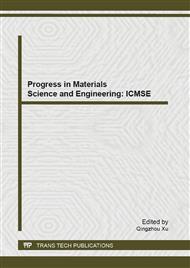[1]
Zhiping Yang, Guangwei Yang, A novel green-emitting phosphor NaCaPO4: Eu2+ for white LEDs, Mater. Lett. 62 (2008) 1884–1886.
DOI: 10.1016/j.matlet.2007.10.030
Google Scholar
[2]
Beiling Yuan, Yanlin Huang, Luminescence and structure of Eu2+-doped Ba2CaMg2Si6O17, Ceram. Int. 38 (2012) 2219–2223.
DOI: 10.1016/j.ceramint.2011.10.070
Google Scholar
[3]
Donglei Wei, Lin Qin, Yanlin Huang, Photoluminescence properties of Eu2+-activated BaCa2Al8O15 nanophosphors, Ceram. Int. 39 (2013) 2383–2387.
DOI: 10.1016/j.ceramint.2012.08.090
Google Scholar
[4]
Suyin Zhang, Yanlin Huang, Luminescence properties and structure of Eu2+ doped KMgPO4 phosphor, Opt. Mater. 32 (2010) 1545–1548.
DOI: 10.1016/j.optmat.2010.06.020
Google Scholar
[5]
Fenghe Wang, Dongzhan Zhou, Preparation and luminescent properties of Eu2+ doped Sr3La(PO4)3 phosphor, J. Alloys Compd. 509 (2011) 4824–4827.
DOI: 10.1016/j.jallcom.2011.01.178
Google Scholar
[6]
Z.C. Wu, J.X. Shi, A novel blue-emitting phosphor LiSrPO4: Eu2+ for white LEDs, J. Solid State Chem. 179 (2006) 2356–2360.
DOI: 10.1016/j.jssc.2006.04.030
Google Scholar
[7]
S. Tanaka, I. Ozaki, T. Kunimoto, Blue emitting CaAl2O4: Eu2+ phosphors for PDP application, J. Lumin. 89 (2000) 1250-1253.
DOI: 10.1016/s0022-2313(99)00544-x
Google Scholar
[8]
Zhanchao Wu, Jie Liu, Thermally stable luminescence of SrMg2(PO4)2: Eu2+ phosphor for white light NUV light-emitting diodes, Chem. Phys. Lett. 466 (2008) 88–90.
DOI: 10.1016/j.cplett.2008.10.034
Google Scholar
[9]
Yong-Kwang Kim, Sungho Choi, Photoluminescence properties of Eu2+ and Mn2+-activated BaMgP2O7 as a potential red phosphor for white-emission, J. Lumin. 130 (2010) 60–64.
DOI: 10.1016/j.jlumin.2009.07.035
Google Scholar
[10]
Ning Guo, Yeju Huang, A tunable single-component warm white-light Sr3Y(PO4)3: Eu2+, Mn2+ phosphor for white-light emitting diodes, Chem. Phys. 13 (2011) 15077–15082.
DOI: 10.1039/c1cp20635d
Google Scholar
[11]
Zhi Huang, Yong-Jie Chen, Fluorescence improvement of Ba13Ca0. 7SiO4: Eu2+, Mn2+ phosphors via Dy3+ addition and their color-tunable properties, Ceram. Int. 39 (2013) 2709-2714.
DOI: 10.1016/j.ceramint.2012.09.038
Google Scholar
[12]
Danuta Dutczak, Alexander Milbrat, Yellow persistent luminescence of Sr2SiO4: Eu2+, Dy3+, J. Lumin. 132 (2012) 2398–2403.
DOI: 10.1016/j.jlumin.2012.03.055
Google Scholar
[13]
Hee-Suk Roh, In-Sun Cho, Jae-Sul An, Enhanced photoluminescence property of Dy3+ co-doped BaAl2O4: Eu2+ green phosphors, Ceram. Int. 38 (2012) 443–447.
DOI: 10.1016/j.ceramint.2011.07.025
Google Scholar


